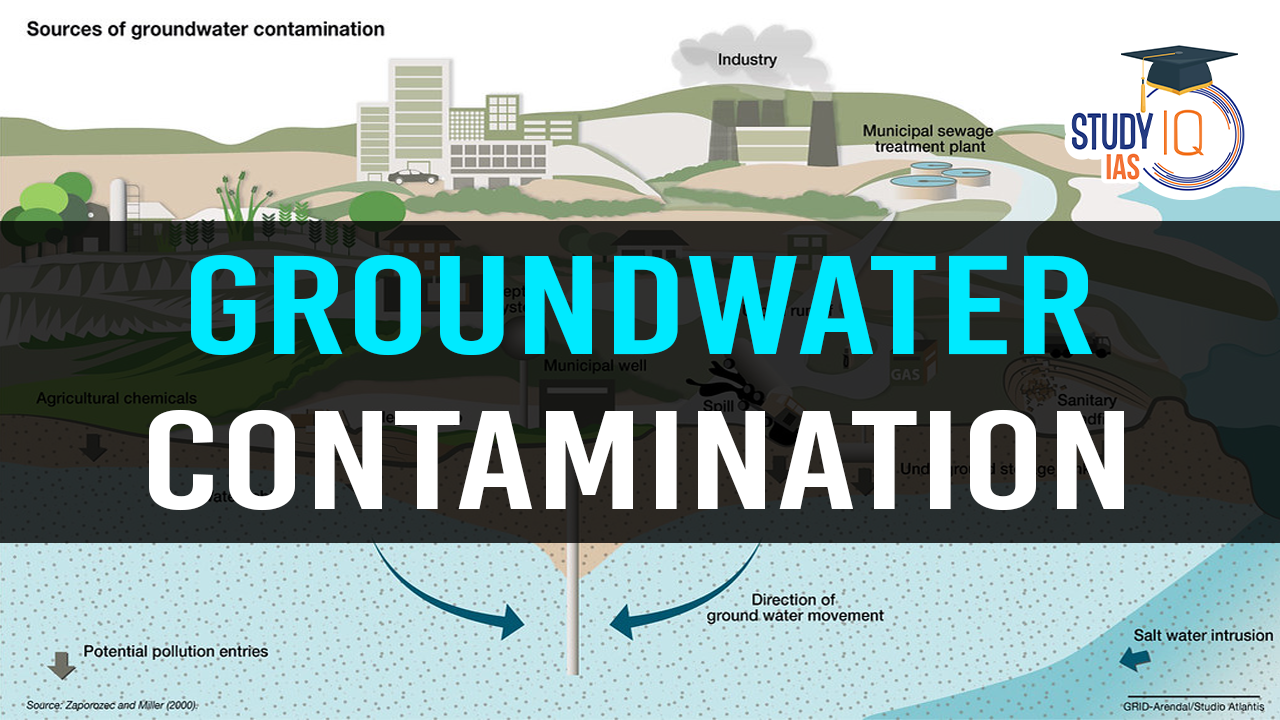Table of Contents
Context: The Annual Groundwater Quality Report 2024, released recently by the Central Groundwater Board, highlights alarming levels of contamination in groundwater across the country.
Status of Groundwater in India
According to the Annual Groundwater Quality Report 2024
- Groundwater Extraction and Usage: Across India, 60.4% of groundwater is currently being extracted, a trend that has
remained stable since 2009. - However, groundwater availability has improved, with 73% of blocks now classified as ‘safe,’ marking a notable rise from 67.4% in 2022.
- Groundwater meets about 85% of rural water supply needs and supports 62% of India’s irrigation requirements.
Findings of the Report
- Nitrate Contamination: 20% of samples exceeded the permissible limit for nitrate.
- Fluoride Contamination: 9.04% of samples had fluoride levels above the limit.
- Arsenic Contamination: Found in 3.55% of samples, especially in the Ganga-Brahmaputra floodplains.
- Contamination hotspots: Rajasthan, Punjab, Haryana, and Andhra Pradesh.
- Uranium Contamination: Uranium contamination affects 6.6 per cent of groundwater samples exceeding the BIS limit of 30 ppb in pre-monsoon 2023.
- Rajasthan and Punjab are most affected; others include Gujarat, Haryana, Tamil Nadu, Andhra Pradesh, and
Karnataka, often in groundwater-stressed zones. - Causes include geogenic factors like granite-rich rocks and anthropogenic inputs like phosphate fertilizers.
- Rajasthan and Punjab are most affected; others include Gujarat, Haryana, Tamil Nadu, Andhra Pradesh, and
- Iron Contamination: Effects 13.2 per cent of groundwater samples exceeding the BIS limit of 1.0 mg/L during pre-monsoon 2023.
- Bihar, Uttar Pradesh, Odisha, West Bengal, Jharkhand, and Chhattisgarh are most impacted, with high
concentrations from the weathering of ferruginous minerals.
- Bihar, Uttar Pradesh, Odisha, West Bengal, Jharkhand, and Chhattisgarh are most impacted, with high
- States like Arunachal Pradesh, Mizoram, and Meghalaya had 100% compliance with Bureau of Indian Standards norms.
Note: 100% of groundwater samples in the North-Eastern States are in the excellent category for irrigation.
|
Groundwater Usage in India |
|
Reasons for Groundwater Contamination
- Natural Factors: Natural leaching of minerals into aquifers.
- Anthropogenic Factors:
- Overuse of chemical fertilizers and pesticides (e.g., Punjab).
- Agricultural runoff leads to nitrate contamination.
- Industrial discharge and untreated sewage.
- Unregulated mining activities.
- Presence of microplastics in urban areas.
- Over-extraction leads to salinity and seawater intrusion in coastal regions.
- Urban Groundwater Issues: Microbial contamination due to improper waste management.
Impacts of Groundwater Contamination
Public Health Hazards
- Contaminants like nitrates, arsenic, and fluoride cause severe health issues:
- Nitrate contamination can lead to methemoglobinemia (blue baby syndrome).
- Arsenic exposure causes skin lesions, cancer, and neurological disorders.
- Excessive fluoride results in dental and skeletal fluorosis.
- Microbial contamination increases the spread of waterborne diseases like diarrhoea and cholera.
Agricultural Productivity Decline
- Contaminated groundwater affects soil fertility and reduces crop yields.
- Harmful substances absorbed by crops enter the food chain, impacting food safety.
- In coastal regions, salinity due to seawater intrusion reduces the productivity of agricultural land.
Economic Losses
- Healthcare costs rise due to diseases caused by polluted groundwater.
- Declining agricultural yields lead to financial losses for farmers.
- Increased costs for industries and households to treat water before use.
Ecosystem Degradation
- Contaminants harm aquatic ecosystems as polluted groundwater often discharges into lakes, rivers, and wetlands.
- Soil degradation due to toxic substances affects biodiversity and plant life.
Social and Equity Issues
- Rural communities, dependent on groundwater, face severe hardships due to contamination.
- Inequities arise as only wealthier households can afford water purification systems.
- Migration may increase as people move away from regions with poor water quality.
Reduced Availability of Safe Drinking Water
- Groundwater contamination decreases access to potable water, especially in rural and urban areas reliant on it.
- Excessive extraction of contaminated groundwater exacerbates water scarcity issues.
Solutions to Address Groundwater Contamination
Improved Water Management
- Promote sustainable agricultural practices.
- Use low-cost water filtration techniques for poor households.
- Recharge aquifers artificially.
- Provide proper sewage disposal systems.
Policy Interventions
- Central schemes like Atal Bhujal Yojana and state programs like Tamil Nadu’s rainwater harvesting.
- Arsenic-mitigation programs in West Bengal.
Community Participation
- Enable local institutions and communities to make decisions regarding groundwater management.
Technological Measures
- Establish hydrogeological monitoring networks.
- Form water security plans at the gram-panchayat level.
Awareness and Regulation
- Launch public-awareness drives.
- Install water meters and formalize rights to groundwater access.
- Enforce groundwater rights detached from land ownership.
Measures taken for Groundwater Management in India
- Water (Prevention and Control of Pollution) Act: Enacted in 1974, it forbids discharging dangerous or contaminating
matter, directly or indirectly, into any stream, well, sewer, or land. - Environment Protection Act, 1986: The Act prohibits a person carrying on any industry, operation or process from
discharging or emitting water pollutants in excess of the prescribed standards - Atal Bhujal Yojana: It is a World Bank assisted central sector scheme, with the goal of community-led sustainable groundwater management.
- Bhu Neer Portal: It is an initiative by the Central Ground Water Authority (CGWA).– It is a digital platform designed to facilitate efficient and transparent management of groundwater resources in India.
- National Water Quality Monitoring Programme (NWMP): Central Pollution Control Board in association with State Pollution Control Boards (SPCBs) and Pollution Control Committees monitor water quality across the country under the NWMP.
- National Project on Aquifer Management: It aims to map the sub-surface water-bearing geological formations in India for informed decision-making.– In addition to mapping, region-wise aquifer management plans are prepared and shared with states to facilitate better management of groundwater resources.
Challenges in Groundwater Management in India
- Jal Shakti Abhiyaan: It is a national campaign launched in 2019 by the Ministry of Jal Shakti to address the issue of water scarcity and ensure water conservation, management, and sustainable use.
- Composite Water Management Index: It is a tool developed by the NITI Aayog to assess and improve the performance of states in the efficient management of water resources.
- Central Groundwater Board: Its objective is to promote sustainable development and management of Ground Water
Resources in India. – The Central Ground Water Authority (CGWA) was constituted under the Environment (Protection) Act, of 1986 for the regulation and control of groundwater development and management in the country. - Ownership Rights: India’s legal framework lacks clear groundwater ownership laws, relying on the outdated Indian Easement Act, of 1882, which links groundwater rights to land ownership.
- Lack of Uniform Guidelines: Groundwater contamination lacks uniform guidelines and is treated through case-based court proceedings such as the ‘polluter pays principle’.
- Limitations of Groundwater Regulations: The Model Groundwater Bill, first passed in 1970 and revised in 2011, 2016, and 2017, granted state groundwater boards the authority to regulate water allocation and usage. – However, these boards struggle to efficiently manage groundwater due to staff shortages, lack of technical expertise, and
a greater focus on industrial regulation. - Issues with Monitoring: The existing network of monitoring stations is sparse, and water quality analyses often omit critical parameters necessary for detecting pollution from fertilizers, pesticides, heavy metals, and other toxic effluents.– E.g., considering the total monitoring points and land area in India, only one CGWB monitoring unit is available for every 100-150 square kilometres.
- Climate change: It poses a challenge in maintaining groundwater quality through altered recharge patterns and aggravated impacts of land use practices.
Way Forward
- Comprehensive Policy Reforms – Implement strict extraction limits in over-exploited regions and introduce incentives
for water-efficient agricultural practices to promote sustainable groundwater use. - Integrated Monitoring Systems – Utilize real-time data analytics to continuously monitor groundwater quality, track
contamination trends, and predict potential risks, enabling timely interventions. - Public Awareness Campaigns – Educate communities about the dangers of groundwater contamination and encourage the adoption of low-cost water treatment technologies to ensure safe drinking water access.
- Targeted Remediation Strategies – Implement region-specific solutions, such as rainwater harvesting in areas prone to salinity intrusion and phosphate reduction techniques to mitigate fluoride and nitrate contamination.
- Better Regulation: All states, as trustees of groundwater, should pass acts to realize the Model Bill 2017 guidelines. – Legal frameworks with stringent regulations and monitoring of groundwater extraction, contamination and recharge can reverse the damages.
- Nature based Solution: – Phytoremediation: Certain plants, such as vetiver grass, willow, and poplar trees, absorb heavy metals, nitrates, and pesticides from contaminated groundwater.– Conservation Buffer: Planting native vegetation along rivers and lakes helps trap sediments, pesticides, and fertilizers before they seep into groundwater.
StudyIQ’s P2I batch offers best-in-class faculty, one-to-one mentorship, curated exam-oriented crux and handwritten notes. Candidates writing mains are offered an all-inclusive Mains Residential Program – all tailored to meet the needs of Hindi-speaking aspirants. Start your journey today and unlock your full potential! Join us today and take the first step toward your UPSC dream!


 Bihar Assembly Election 2025 Dates, Poli...
Bihar Assembly Election 2025 Dates, Poli...
 Bharat Bandh 9 July 2025: Over 25 Crore ...
Bharat Bandh 9 July 2025: Over 25 Crore ...
 Sukhoi Su-57: Will India Choose Russia�...
Sukhoi Su-57: Will India Choose Russia�...





















